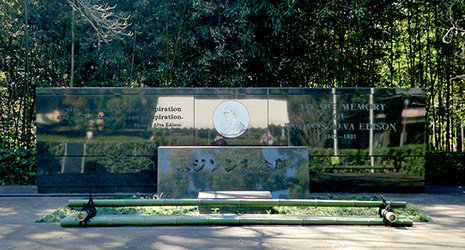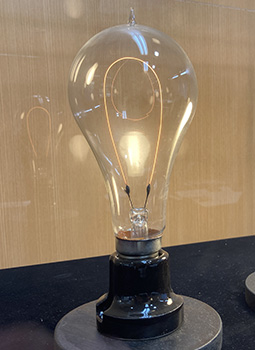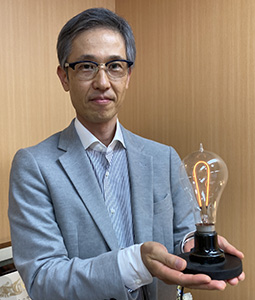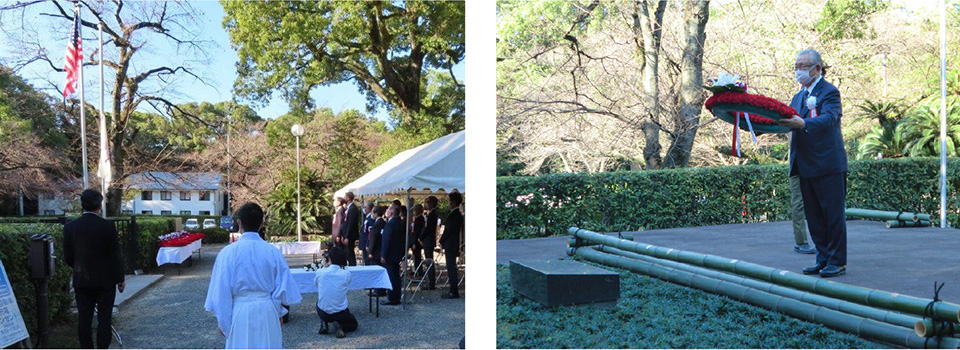August 2022
- English
- 日本語
Thomas Edison: The Incandescent Light Bulb and Japanese Bamboo

The monument to Edison located in the precincts of the Iwashimizu Hachimangu Shrine 
Thomas Edison (1847–1931)

A replica of a light bulb using a bamboo filament 
Oikawa Yoshiki, managing director of the Japan Electric Association, holds an incandescent light bulb made from a bamboo filament

A species of bamboo from Kyoto Prefecture in Japan played an important role in the commercialization of the first incandescent light bulbi, developed by the American inventor Thomas Edison (1847–1931).

In Yawata City, southern Kyoto Prefecture, there is an area that features an expanse of beautiful, well-maintained bamboo grooves. These bamboo groves form a ring around the Iwashimizu Hachimangu Shrine complex that was founded in the year 859. The high-quality native madake species of bamboo grows here, and is called Hachiman-dake (Hachiman Bamboo).
That this Hachiman bamboo played an important role in the practical application and global adoption of the incandescent light bulb at the end of the nineteenth century is not widely known. The American inventor Thomas Edison ultimately achieved the first practical incandescent light bulb, but initially struggled to find a suitable material to act as the light-emitting filament, a key component of the light bulb, before his search finally led to Hachiman bamboo.
“At the time, many researchers were working on the development of incandescent light bulbs, when in 1879 Edison succeeded in lighting a bulb using a filament made from carbonized cotton yarn, which he improved to allow for 40 hours continuous burning. While this brought Edison great fame, he was not satisfied, and he continued to experiment with carbonized materials, eventually testing as many as 6,000 types of material in order to make an even better filament,” explains Oikawa Yoshiki, managing director of the Japan Electric Association.

In the course of his research, Edison happened upon bamboo used in the frame of a folding fan that was in his laboratory, and when he tested it as a filament, he achieved excellent results. In response, he dispatched researchers around the world in search of bamboo that would be suitable as a filament. In 1880, one of his researchers discovered the wild-growing Hachiman bamboo surrounding the Iwashimizu Hachimangu Shrine.
Hachiman bamboo is highly durable and flexible, with thick and sturdy fibers. What’s more, it does not burn out easily, and Edison was able to achieve a continuous lighting period of 1,200 hours using Hachiman bamboo as a filament. Additionally, since the distance between the nodes on the bamboo stems was just the right length, it was truly the ideal filament for which Edison had been searching.
This is how incandescent light bulbs manufactured from around 1881 using Hachiman bamboo exported from Japan became a hit product and, until a new filament was discovered in 1894, continued to brighten the lives of people around the world.
“Even in Japan, for those of us involved in electricity-related work, it is no exaggeration to describe Edison as the greatest of all time, since he made tremendous efforts to invent the incandescent light bulb and electric power supply system. To honor Edison’s achievements and pass on his passion to young people and future generations, in 1956 the Edison Shotokukai was established as a foundation to acknowledge Edison’s achievements in Japan,” says Oikawa, who also serves as managing director of the foundation.

In 1934 a first monument to Edison was placed in an area close to the Iwashimizu Hachimangu Shrine that sits in the center of the Hachiman bamboo groves that contributed to the practical utilization of incandescent light bulbs. The monument was later moved to its current location on the southern side of the precincts in 1958. And in 1984, through the efforts of the Edison Shotokukai, the monument was rebuilt. Incidentally, the placement of this new monument in 1984 led to a friendship city relationship forming between Yawata City and the village of Milan in the US state of Ohio, the birthplace of Edison, with exchanges continuing to this day.
In addition to handling the maintenance and management of the monument, the Edison Shotokukai holds a memorial service around October 18 each year, the anniversary of Edison’s death. On this day, for remembering Edison’s great achievements, the flags of both Japan and the United States are hoisted, US officials such as the Consul General of the United States of America in Osaka-Kobe are invited, and flowers are offered. Additionally, once every five years, a grand festival is held around the same time, and involves commemorative activities such as distributing booklets detailing Edison’s accomplishments to local elementary school students.
Today, more than 140 years since Japanese bamboo was used to produce the world’s first practical incandescent light bulb, exchanges between Japan and the United States in memory of Edison, the great inventor, are continuing uninterrupted in places connected historically to him.

* A light bulb that uses light from a luminous part (filament) inside a glass bulb, which is heated by passing an electric current through it.

